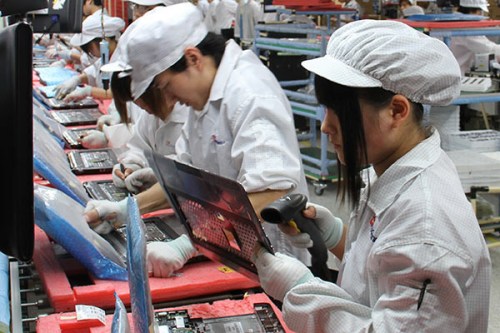
Technicians at work on a production line of Foxconn Industrial Internet Co in Chongqing Xiyong Comprehensive Bonded Zone. Foxconn received the regulatory approval for its planned IPO in just 36 days. (Photo provided to China Daily)
SMEs in innovation sector may shine, but growth stocks retain allure for investors
Starting later this year, China's A-share market is expected to see listings of science and technology unicorns, or startups with a valuation of $1 billion or more each.
Around the same time, the Chi-Next, China's Nasdaq-style board for tech stocks on the Shenzhen Stock Exchange, is also expected to rebound, having been in a downturn over the last three years.
"The country's policy is to rejuvenate the economy through emphasis on science and technology. So, the idea that the small and medium-sized stocks can rise further has received much attention," said Zhu Bin, an analyst with Southwest Securities in Shanghai.
At the beginning of this month, the China Securities Regulatory Commission decided to fast-track approvals for IPO applications of valuable startups in four areas (biotechnology, cloud computing, artificial intelligence and advance manufacturing).
Foxconn Industrial Internet Co, a contract manufacturer of mobile phones for Apple, received the regulatory approval for its planned IPO in just 36 days.
On listing, Foxconn's stock would be part of China's A shares, underlining the determination of market regulators to support New Economy enterprises.
After the approval, the Growth Enterprises Market Index rose 2.5 percent on March 9, while the benchmark Shanghai Composite Index rose only 0.1 percent.
That is significant because China's small and medium-sized companies once suffered from unrealistically high valuations that were not supported by performance. Bloomberg forecast that the price-to-earnings ratio for the year will likely fall from more than 80 times to 24 times the current level.
However, even though the market is picking up, most institutional investors and analysts interviewed by Bloomberg still believe that the future trend of small and medium-sized firms' innovation will be divided, and only the so-called "growth stocks" are worth buying.
"The key words are cheap stocks and good performance, and growth stocks can be found in the SME Board, ChiNext and in stocks whose code starts with 603," said Zhu. (The code of shares listed on the Shanghai motherboard begins with 603; all Shanghai-listed shares' code begins with 6.)
"GEM stocks are quite divided. It is better to look at the valuation of companies and industries, and whether there is a good business model, instead of focusing on block size and style," said Wei Xinyuan, an investment manager of private equity fund Windsor Capital in Beijing.
If the price-to-earnings ratio of tech giants in the A-share market reaches 23, it would be attractive to many investors, according to Hou Chunxiao, an analyst with China Merchants Securities.
"If these companies go public, investors will be willing to join in the equity participation based on this ratio," said Hou. He said in the past, investors tended to appreciate those unicorn companies that have not been listed or had listed on overseas markets.
According to TF Securities' report on March 6, domestic institutions and overseas funds were previously concentrated on white horse shares, which bring liquidity risk to the A-share market.
As a result, the regulators have recently been preoccupied with the task of correcting the "80/20" market pattern, which refers to a phenomenon that roughly 20 percent of the weighted shares in a market have up to 80 percent influence on the direction of a major trend.
In the short term, the 80/20 pattern is aimed at resolving risks; in the long run, it is to pave the way for tech giants such as Baidu, Alibaba, Tencent and JD, which are listed overseas, to also list on the domestic bourses.
The best strategy is to buy undervalued growth stocks with high growth potential, said the TF report.
Since the Lunar New Year began on Feb 16, the ChiNext index has soared nearly 12 percent, while the SCI and the Hushen 300 Index, which represents blue chip stocks, have risen only 3 percent.
During the two sessions in Beijing, CEOs of tech companies listed in the US, such as Baidu and Sogou, have expressed their hope to list on the A-share market.
Apart from domestic institutions, overseas funds have begun to focus on small-cap stocks listed on the A-share market, market people said.


















































